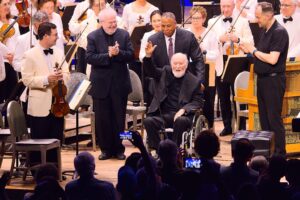John Williams’ Piano Concerto at Tanglewood

The audience greeted John Williams like he was a rock star.
Indeed, this composer’s music for blockbuster films like Star Wars, Jaws and Jurassic Park is well known and loved by billions around the world. People, including those in attendance at Tanglewood on Saturday night, July 26, love him for his concert music as well. Williams appeared on stage after the crowd-pleasing premiere performance of his Concerto for Piano and Orchestra with soloist Emanuel Ax and the Boston Symphony Orchestra led by Andris Nelsons.
Williams has been a mainstay at the BSO for decades, having been music director of the Boston Pops Orchestra from 1980 to 1993; and composed numerous scores especially for the venerable ensemble and some of its principal players. He began writing the newest work in his immense catalogue of concert music in 2022, at age 90, this one specifically for Ax and the BSO.
For this three-movement work, Williams drew his inspiration from jazz greats Art Tatum, Bill Evans, and Oscar Peterson. From the very start in the “Introduction – Colloquy (Art Tatum)”, the composition launched into bold jazz chords from the soloist. The rhythms went beyond ragtime, instantly recalling Tatum’s trademark stride piano style. The textures, timbres and sonorities of the jazz-infused score were as vividly colorful as Williams’ film scores. The rich viola solo of the second movement “Listening (Bill Evans)” was straight and somber, infused with angular and dissonant sonorities. The clamorous timpani opening the work’s third movement (“Finale. Presto (Oscar Peterson)”) echoed the beginning of Gershwin’s majestic Piano Concerto in F. This movement was the most virtuosic of the already technically demanding piece, using the entire range of the keyboard. Thunderous ovations followed the final chord.
Concert-goers who departed the grounds after the triumphant world premiere missed a powerful reading of Mahler’s Symphony No. 1. Any flaws early in the performance were brushed aside as the second movement unfolded with crisp execution, the rocksteady timpanist emphasized the foundations of the tonality for most of the third movement, and the confident swagger in the secondary theme. Nelsons brought it all to an exciting conclusion full of contrast in both dynamics and tempi.
The BSO brass deserve a medal. They were knockouts in both works on the program. From the colorful character of John William’s concerto to their mighty display in the Mahler, they shone in every which way. The entire horn section standing for the final section of the Mahler was emblematic of the section’s performance throughout.